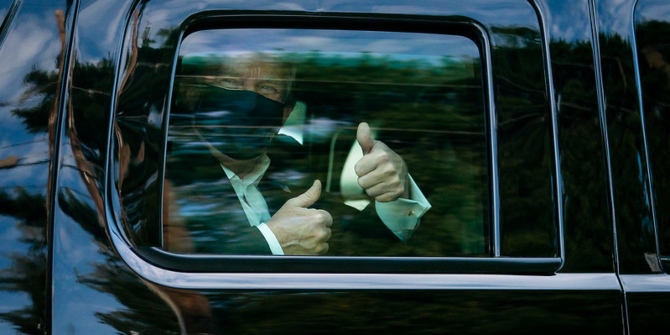 And so it begins. No soft launch, no early days honeymoon. The first weeks of the Trump presidency have unfolded – exploded – in a boisterous and provocative fashion that must have satisfied those wanting to “let Trump be Trump.” Ron Pruessen shares some early thoughts about the spectacle.
And so it begins. No soft launch, no early days honeymoon. The first weeks of the Trump presidency have unfolded – exploded – in a boisterous and provocative fashion that must have satisfied those wanting to “let Trump be Trump.” Ron Pruessen shares some early thoughts about the spectacle.
I’ve been struck lately by the way we have moved from the 500th anniversary celebrations of Hieronymus Bosch in 2016 to the 2017 launch of the Trump presidency. Last year: painterly visions of the grotesque and frightening. Now: 21st century vivifications? (Vivisections too, if we contemplate the new president’s plans for the Obama legacy).
Bosch could bedazzle the eye with imagery that shape shifted from seemingly normal into depictions of the human capacity for absurdity, sin, ugliness, and endangerment. In his hands, the Low Countries charm that would later come to the fore (with Breughel the Younger, for instance) was infused with a thwack of magic realism – although “voodoo realism” might be a better term. The Garden of Earthly Delights, for instance, moved (literally left to right) from an Eden-like vision of innocence (Adam and Eve being introduced by a God/Jesus figure) to giddy fornication and indulgence (fueled by steroid-zapped grapes, strawberries, and blackberries) and then again to torture or destruction (at the hands of urban fires and “fantastic beasts” that could have inspired J.K. Rowling). The dozens of miniature scenes in this and his other works show Bosch’s stunning, still potent power to rattle: as the familiar becomes haunted, he unmoors us from any sense that the real world is securely safe and comfortable.
Which brings us to Donald Trump and the prospect of voodoo realism in 2017. We have well-known, presumably familiar settings: the White House, the Capitol, even the CIA’s headquarters – as recognizable as placid green fields and ponds would have been to those viewing Bosch’s terrain. There are also clearly identifiable humans. (True, they’re wearing clothes in 2017 – as long as we ignore the First Lady’s early photo shoot and that naked statue of the Donald that popped up in New York’s Union Square for a while.) And yet, if we swipe right – as Bosch wanted his audience to do in their 16th century way, by shifting their gaze across his panels – we are also smacked by images with the capacity to unsettle.
Bosch painted bodies literally strung up in an anthropomorphic harp and mandolin. We have journalists and citizens ensnared by sometimes ludicrous presidential tweets, “alternative facts,” and injunctions to the media to “keep its mouth shut.”

Bosch had a pack of gray and lime komodo dragon/rat-like hybrids disemboweling a fallen knight in armor. We have a Trump team quickly eviscerating (or trying to) inherited values and policies: executive orders imposing severe restrictions on immigration – and the speedy construction of the notorious southern wall; a Vice-President pledging moves against abortion rights – and prospective Supreme Court nominations that could escalate that threat; swift sword slices taken off freer trade practices and projected initiatives like TPP; sieve-like safeguards against conflict of interest abuses by the billionaire president. All this within one week, and not even a complete list.
Bosch put a smoking, charred, and crumbling city in the background of his tortured landscape. Will that too have its counterpart in 2017, as the foundations of the proverbial American “city on a hill” are shaken by Trumpian trumpet blasts? How weak will Jericho’s ramparts prove to be? If you have the appetite, try your hand – and eyes – at finding other signs of 2017 in Bosch’s work. It may now be 501 years since his death, but the paintings can still astonish.
Trump’s journey through the American and global landscape has barely begun, of course, and a wide canvas waits to be filled. That said, it is difficult at this moment to imagine that the currently blank surfaces will eventually radiate the bucolic charm that Bosch was able to at least imagine as his starting point. If we begin where Bosch ended, what in heaven’s (or hell’s) name is yet to come? I will wait to find out, of course – and like the hypothetically stodgy “scholar” I try to be, I really do believe in the importance of objectively gathering evidence. I find it entirely conceivable, for instance, that a massive Trump initiative on infrastructure could have a positive impact on US jobs and incomes – something the Republican-controlled Congress was unwilling to allow Obama to do. At the moment, though, it’s the Boschian visions of pain and destruction that are coming to mind – prodding fear that we’ll be doing anything but celebrating the new variations even in 5 years, much less 500.
Featured image credit: Hieronymus Bosch (circa 1450–1516) [Public domain], via Wikimedia Commons
Please read our comments policy before commenting.
Note: This article gives the views of the author, and not the position of USAPP – American Politics and Policy, nor of the London School of Economics.
Shortened URL for this post: http://bit.ly/2k2CqUu
_________________________________________
 Ron Pruessen – University of Toronto
Ron Pruessen – University of Toronto
Ronald W. Pruessen has served as the Munk School of Global Affairs’ Director for International Partnerships & Research and is former Chair of the Department of History, University of Toronto. His primary research and teaching interests are in 20th century US foreign policy and international relations. Early work focused on the Cold War (e.g., John Foster Dulles: To the Threshold, 1888-1952) and he recently co-edited (with Soraya Castro) Fifty Years of Revolution: Perspectives on Cuba, the United States, and the World. He is currently writing a study of the way Barack Obama’s foreign policies relate to deeply rooted American views and behavior.






